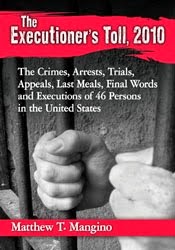For opponents of the death penalty, this has been something of a heartening year, reported Scott Martelle of the
Los Angeles Times. The country is on a pace for its
fewest executions since 1994, and although public support for the death penalty
remains at a stubborn majority,
high-profile exonerations and
botched executions have led to new calls for its abolition. And with states finding it increasingly difficult to procure the drugs needed for executions, states are carrying out fewer executions — with the
exception of Missouri.
Some quotes and observations fromt he past year:
"For all practical purposes then, a sentence of death in California is a sentence of life imprisonment with the remote possibility of death — a sentence no rational legislature or jury could ever impose.
"Of course, for an arbitrarily selected few of the 748 inmates currently on Death Row, that remote possibility may well be realized. Yet their selection for execution will not depend on whether their crime was one of passion or of premeditation, on whether they killed one person or ten, or on any other proxy for the relative penological value that will be achieved by executing that inmate over any other. Nor will it even depend on the perhaps neutral criterion of executing inmates in the order in which they arrived on Death Row. Rather, it will depend upon a factor largely outside an inmate’s control, and wholly divorced from the penological purposes the State sought to achieve by sentencing him to death in the first instance: how quickly the inmate proceeds through the state’s dysfunctional post-conviction review process."
"The overwhelming majority of those facing execution today have what the court termed in Hall to be diminished culpability. Severe functional deficits are the rule, not the exception, among the individuals who populate the nation’s death rows. A new study by Robert J. Smith, Sophie Cull and Zoë Robinson, published in Hastings Law Journal, of the social histories of 100 people executed during 2012 and 2013 showed that the vast majority of executed offenders suffered from one or more significant cognitive and behavioral deficits….
"As the execution of Elroy Chester, John Ferguson, Daniel Cook and many more like them illustrates, barring the death penalty for intellectually disabled and juvenile offenders did not solve the death penalty’s dignity problem. Rather, those cases gave us cause to look more closely at the people whom we execute. And when you look closely, what you find is that the practice of the death penalty and the commitment to human dignity are not compatible."
--Charles J. Ogletree Jr., Harvard Law School professor
"Then at 2:05, Wood's mouth opened. Three minutes later it opened again, and his chest moved as if he had burped. Then two minutes again, and again, the mouth open wider and wider. Then it didn't stop.
"He gulped like a fish on land. The movement was like a piston: The mouth opened, the chest rose, the stomach convulsed. And when the doctor came in to check on his consciousness and turned on the microphone to announce that Wood was still sedated, we could hear the sound he was making: a snoring, sucking, similar to when a swimming-pool filter starts taking in air, a louder noise than I can imitate, though I have tried.
"It was death by apnea. And it went on for an hour and a half. I made a pencil stroke on a pad of paper, each time his mouth opened, and ticked off more than 640, which was not all of them, because the doctor came in at least four times and blocked my view.
"I turned to my friend Troy Hayden, the anchor and reporter from Fox 10 News, who was sitting next to me. Troy and I witnessed another execution together in 2007, and he had seen one before that, so he also knows what it looks like.
"'I don't think he's going to die,' I said."
—Michael Kiefer, Arizona Republic reporter who witnessed the botched, nearly two-hour execution of Joseph Woods
"When you’re talking about the ultimate penalty, when you’re talking about the state taking someone’s life, there has to be a great deal of flexibility within the system to deal with things like deadlines. There is always a need for finality in the system, that is a good thing. But there has to be enough flexibility so that you can look at the substance of a claim, especially when the death penalty is at stake. If you rely on process to deny what could be a substantive claim, I worry about where that will lead us.
"I disagree very much with
Justice Scalia’s certitude that we have never put to death an innocent person. It’s one of the reasons why I personally am opposed to the death penalty. We have the greatest judicial system in the world, but at the end of the day it’s made up of men and women making decisions, tough decisions. Men and women who are dedicated, but dedicated men and women can make mistakes. And I find it hard to believe that in our history that has not happened.”
—Eric H. Holder Jr., U.S. attorney general
"It’s terrifying that our justice system allowed two intellectually disabled children to go to prison for a crime they had nothing to do with, and then to suffer there for 30 years. Henry watched dozens of people be hauled away for execution. It’s impossible to put into words what these men have been through and how much they have lost.”
—Ken Rose, lawyer for half-brothers Henry McCollum and Leon Brown of North Carolina, who were released after more than 30 years in prison for a murder they did not commit.
"I just thank God that I’m out of this place. I knew one day that I was going to be blessed to get out of prison, I just didn’t know when that time was going to be….They took 30 years away from me for no reason, but I don’t hate them. I don’t hate them one bit.”
—Henry McCollum upon leaving prison
"Florida seeks to execute a man because he scored a 71 instead of 70 on an IQ test. Florida is one of just a few States to have this rigid rule. Florida’s rule misconstrues the Court’s in Atkins that intellectually disability is characterized by an IQ of 'approximately 70.' Florida’s rule is in direct opposition to the views of those who design, administer, and interpret the IQ test. By failing to take into account the standard error of measurement, Florida’s law not only contradicts the test’s own design but also bars an essential part of a sentencing court’s inquiry into adaptive functioning. Freddie Lee Hall may or may not be intellectually disabled, but the law requires that he have the opportunity to present evidence of his intellectual disability, including deficits in adaptive functioning over his lifetime.
"The death penalty is the gravest sentence our society may impose. Persons facing that most severe sanction must have a fair opportunity to show that the Constitution prohibits their execution. Florida’s law contravenes our Nation’s commitment to dignity and its duty to teach human decency as the mark of a civilized world. The States are laboratories for experimentation, but those experiments may not deny the basic dignity the Constitution protects."
—Supreme Court Justice Anthony M. Kennedy in Hall vs. Florida
"To this day, Mr. Panetti hears voices and experiences delusions. Chief among his delusions is the belief that the State of Texas seeks to kill him to prevent him from preaching the Gospel to his fellow inmates on Texas death row and from exposing rampant corruption at the Texas Department of Criminal Justice. He cannot rationally understand that he is being executed for the murder of his wife’s parents. …
"Seven years have now elapsed since mental health experts last evaluated Mr. Panetti. During that time, no cure has been discovered for schizophrenia, and Mr. Panetti’s mental condition continues to decline. Texas’ rush to execute Mr. Panetti is unseemly. Undersigned counsel, who have represented Mr. Panetti for nearly a decade, became aware of Mr. Panetti’s current execution date only after a newspaper article appeared in the Houston Chronicle on October 30, 2014. Only then did counsel discover that the State had issued the Execution Warrant two weeks earlier, on October 16, 2014. The State’s failure to provide counsel with any notice in a case of this magnitude, where compelling questions of sanity and competency remain at issue, is unconscionable.”
—Kathryn M. Kade and Gregory W. Wiercioch, Scott Panetti’s attorneys, in a filing seeking clemency before his scheduled Dec. 3 execution in Texas. A federal appeals court has stayed the execution.
To read more
CLICK HERE







